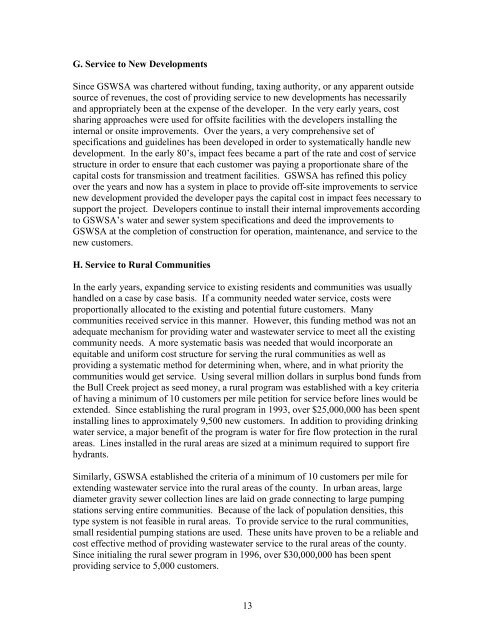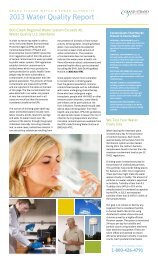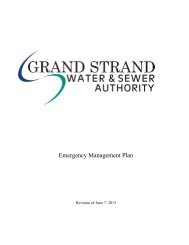2030 Plan - Grand Strand Water and Sewer Authority
2030 Plan - Grand Strand Water and Sewer Authority
2030 Plan - Grand Strand Water and Sewer Authority
You also want an ePaper? Increase the reach of your titles
YUMPU automatically turns print PDFs into web optimized ePapers that Google loves.
G. Service to New Developments<br />
Since GSWSA was chartered without funding, taxing authority, or any apparent outside<br />
source of revenues, the cost of providing service to new developments has necessarily<br />
<strong>and</strong> appropriately been at the expense of the developer. In the very early years, cost<br />
sharing approaches were used for offsite facilities with the developers installing the<br />
internal or onsite improvements. Over the years, a very comprehensive set of<br />
specifications <strong>and</strong> guidelines has been developed in order to systematically h<strong>and</strong>le new<br />
development. In the early 80’s, impact fees became a part of the rate <strong>and</strong> cost of service<br />
structure in order to ensure that each customer was paying a proportionate share of the<br />
capital costs for transmission <strong>and</strong> treatment facilities. GSWSA has refined this policy<br />
over the years <strong>and</strong> now has a system in place to provide off-site improvements to service<br />
new development provided the developer pays the capital cost in impact fees necessary to<br />
support the project. Developers continue to install their internal improvements according<br />
to GSWSA’s water <strong>and</strong> sewer system specifications <strong>and</strong> deed the improvements to<br />
GSWSA at the completion of construction for operation, maintenance, <strong>and</strong> service to the<br />
new customers.<br />
H. Service to Rural Communities<br />
In the early years, exp<strong>and</strong>ing service to existing residents <strong>and</strong> communities was usually<br />
h<strong>and</strong>led on a case by case basis. If a community needed water service, costs were<br />
proportionally allocated to the existing <strong>and</strong> potential future customers. Many<br />
communities received service in this manner. However, this funding method was not an<br />
adequate mechanism for providing water <strong>and</strong> wastewater service to meet all the existing<br />
community needs. A more systematic basis was needed that would incorporate an<br />
equitable <strong>and</strong> uniform cost structure for serving the rural communities as well as<br />
providing a systematic method for determining when, where, <strong>and</strong> in what priority the<br />
communities would get service. Using several million dollars in surplus bond funds from<br />
the Bull Creek project as seed money, a rural program was established with a key criteria<br />
of having a minimum of 10 customers per mile petition for service before lines would be<br />
extended. Since establishing the rural program in 1993, over $25,000,000 has been spent<br />
installing lines to approximately 9,500 new customers. In addition to providing drinking<br />
water service, a major benefit of the program is water for fire flow protection in the rural<br />
areas. Lines installed in the rural areas are sized at a minimum required to support fire<br />
hydrants.<br />
Similarly, GSWSA established the criteria of a minimum of 10 customers per mile for<br />
extending wastewater service into the rural areas of the county. In urban areas, large<br />
diameter gravity sewer collection lines are laid on grade connecting to large pumping<br />
stations serving entire communities. Because of the lack of population densities, this<br />
type system is not feasible in rural areas. To provide service to the rural communities,<br />
small residential pumping stations are used. These units have proven to be a reliable <strong>and</strong><br />
cost effective method of providing wastewater service to the rural areas of the county.<br />
Since initialing the rural sewer program in 1996, over $30,000,000 has been spent<br />
providing service to 5,000 customers.<br />
13






